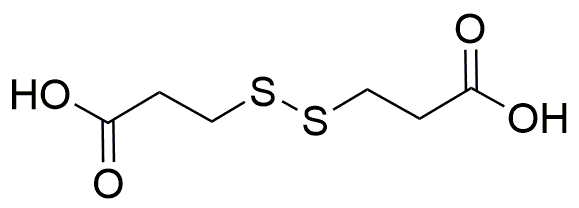3,3'-Dithiodipropionic acid is widely utilized in research focused on:
- Antioxidant Applications: This compound is effective in preventing oxidative stress in various biological systems, making it valuable in food preservation and cosmetics to enhance shelf life and stability.
- Polymer Chemistry: It serves as a cross-linking agent in the production of polymers, improving the mechanical properties and thermal stability of materials used in coatings and adhesives.
- Bioconjugation: Researchers use it to create stable linkages between biomolecules, facilitating the development of targeted drug delivery systems and diagnostic tools in biomedicine.
- Surface Modification: The compound is employed in modifying surfaces to enhance biocompatibility in medical devices, making them safer and more effective for patient use.
- Research in Redox Biology: It is utilized in studies related to redox signaling, helping scientists understand cellular processes and the role of thiols in various diseases.
General Information
Properties
Safety and Regulations
Applications
3,3'-Dithiodipropionic acid is widely utilized in research focused on:
- Antioxidant Applications: This compound is effective in preventing oxidative stress in various biological systems, making it valuable in food preservation and cosmetics to enhance shelf life and stability.
- Polymer Chemistry: It serves as a cross-linking agent in the production of polymers, improving the mechanical properties and thermal stability of materials used in coatings and adhesives.
- Bioconjugation: Researchers use it to create stable linkages between biomolecules, facilitating the development of targeted drug delivery systems and diagnostic tools in biomedicine.
- Surface Modification: The compound is employed in modifying surfaces to enhance biocompatibility in medical devices, making them safer and more effective for patient use.
- Research in Redox Biology: It is utilized in studies related to redox signaling, helping scientists understand cellular processes and the role of thiols in various diseases.
Documents
Safety Data Sheets (SDS)
The SDS provides comprehensive safety information on handling, storage, and disposal of the product.
Product Specification (PS)
The PS provides a comprehensive breakdown of the product’s properties, including chemical composition, physical state, purity, and storage requirements. It also details acceptable quality ranges and the product's intended applications.
Certificates of Analysis (COA)
Search for Certificates of Analysis (COA) by entering the products Lot Number. Lot and Batch Numbers can be found on a product’s label following the words ‘Lot’ or ‘Batch’.
Numéro de catalogue
Numéro de lot/série
Certificates Of Origin (COO)
This COO confirms the country where the product was manufactured, and also details the materials and components used in it and whether it is derived from natural, synthetic, or other specific sources. This certificate may be required for customs, trade, and regulatory compliance.
Numéro de catalogue
Numéro de lot/série
Safety Data Sheets (SDS)
The SDS provides comprehensive safety information on handling, storage, and disposal of the product.
DownloadProduct Specification (PS)
The PS provides a comprehensive breakdown of the product’s properties, including chemical composition, physical state, purity, and storage requirements. It also details acceptable quality ranges and the product's intended applications.
DownloadCertificates of Analysis (COA)
Search for Certificates of Analysis (COA) by entering the products Lot Number. Lot and Batch Numbers can be found on a product’s label following the words ‘Lot’ or ‘Batch’.
Numéro de catalogue
Numéro de lot/série
Certificates Of Origin (COO)
This COO confirms the country where the product was manufactured, and also details the materials and components used in it and whether it is derived from natural, synthetic, or other specific sources. This certificate may be required for customs, trade, and regulatory compliance.

